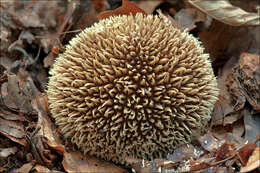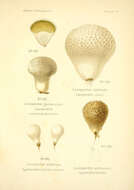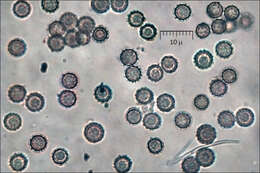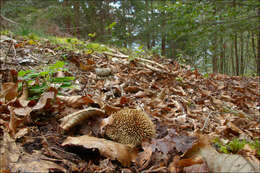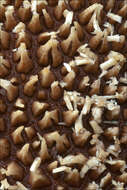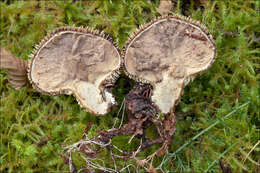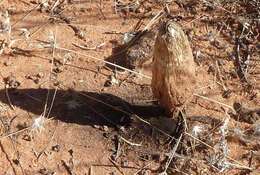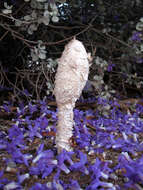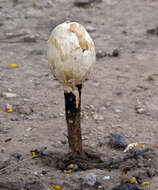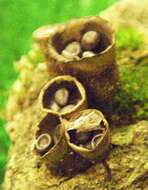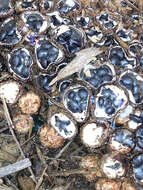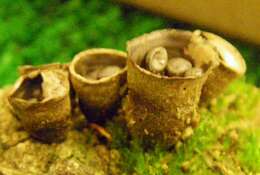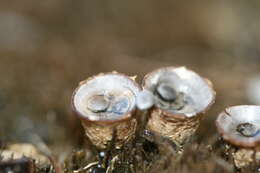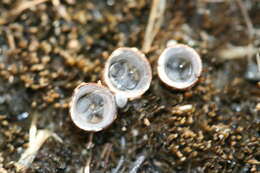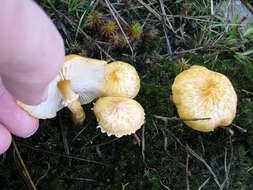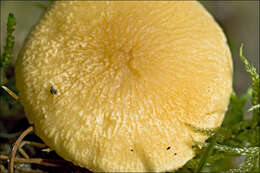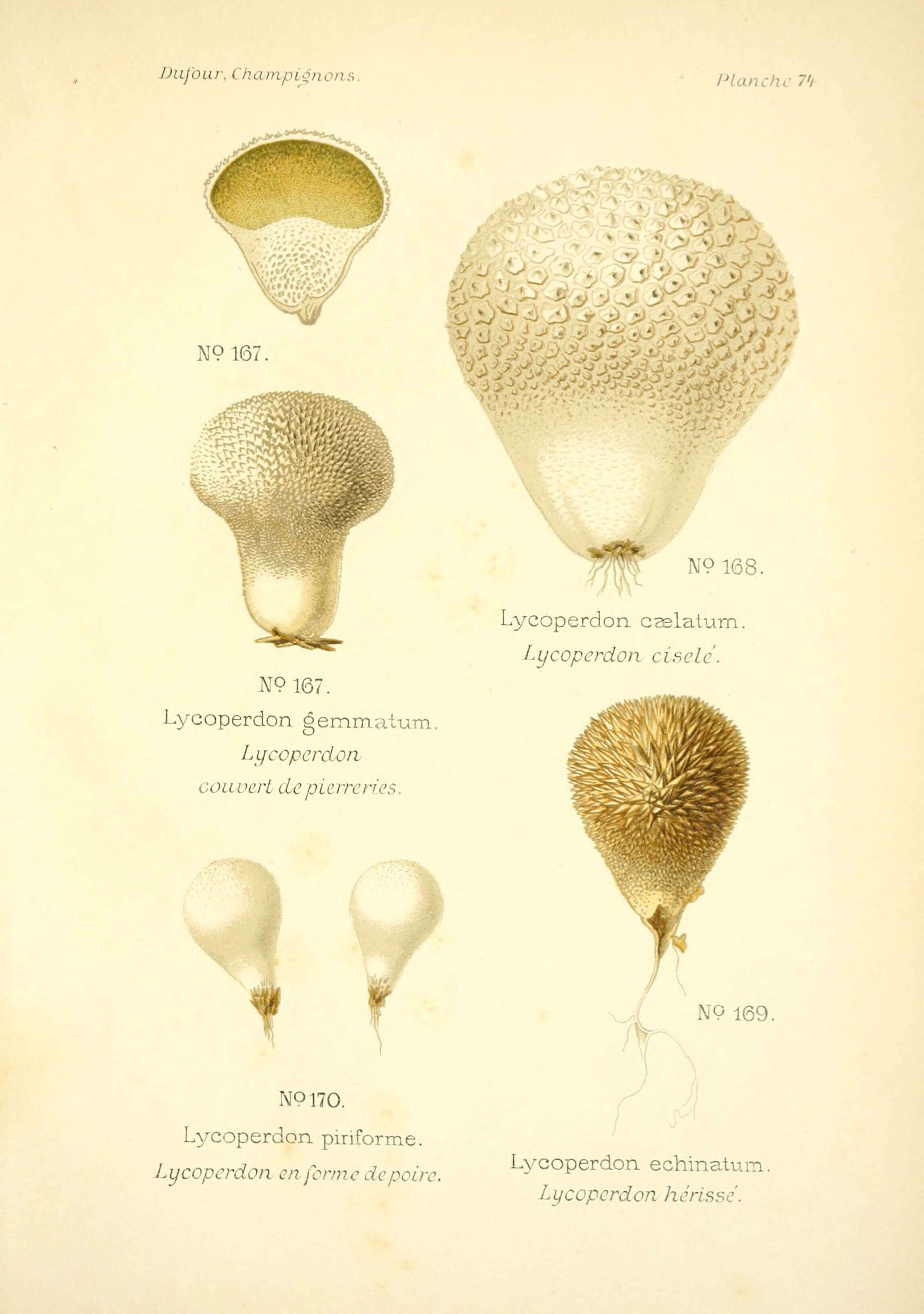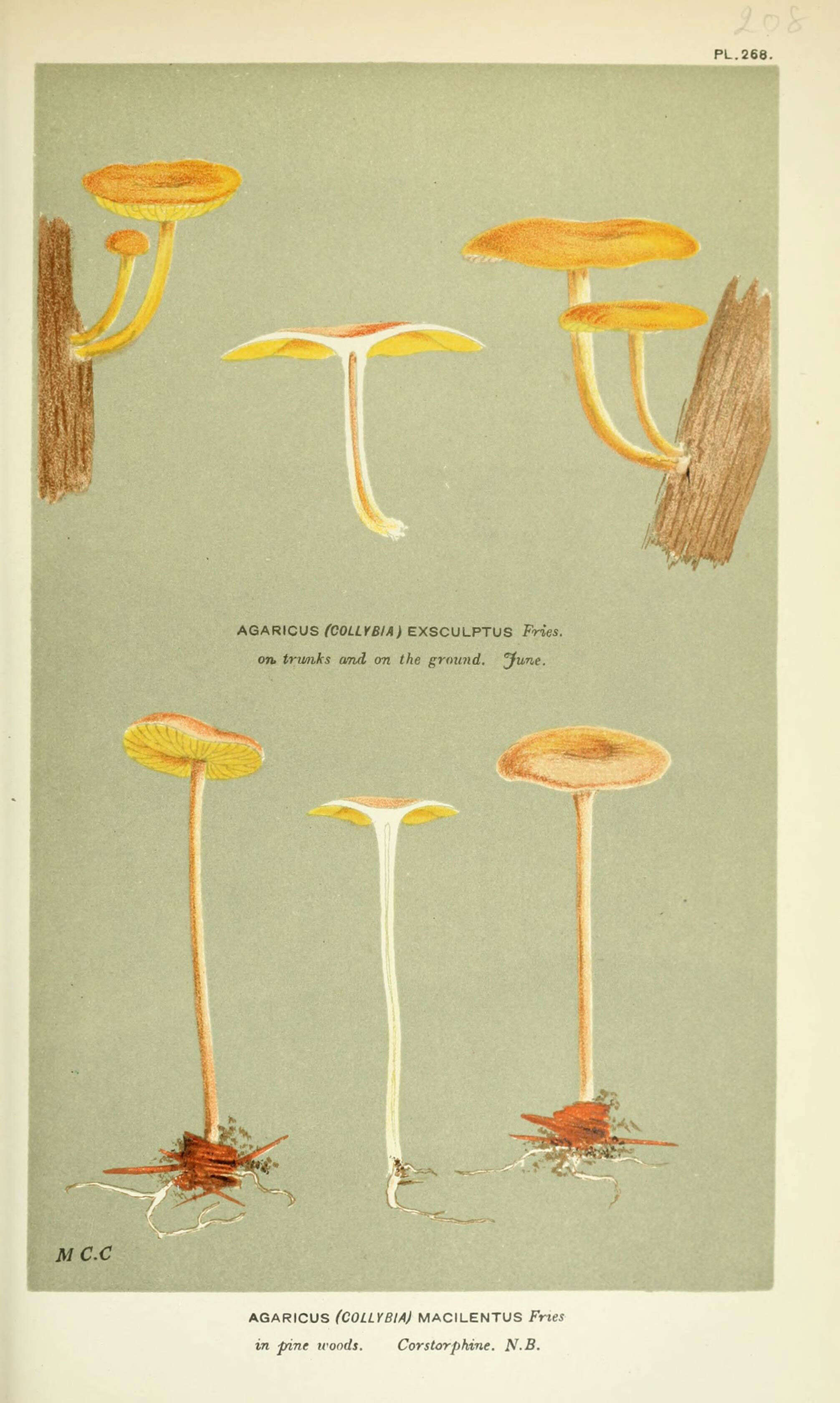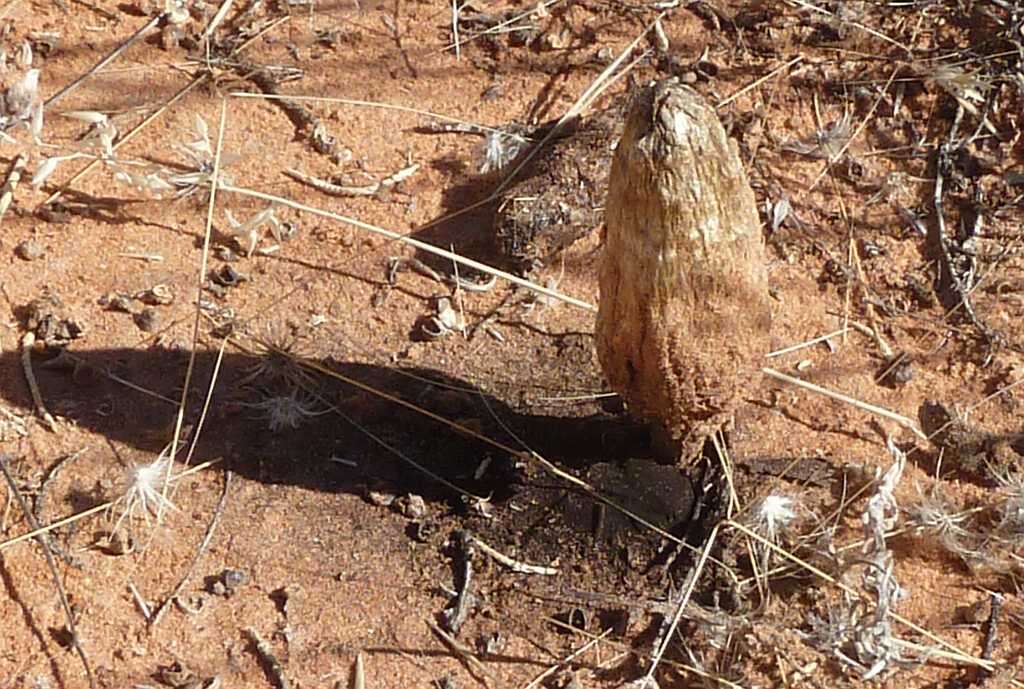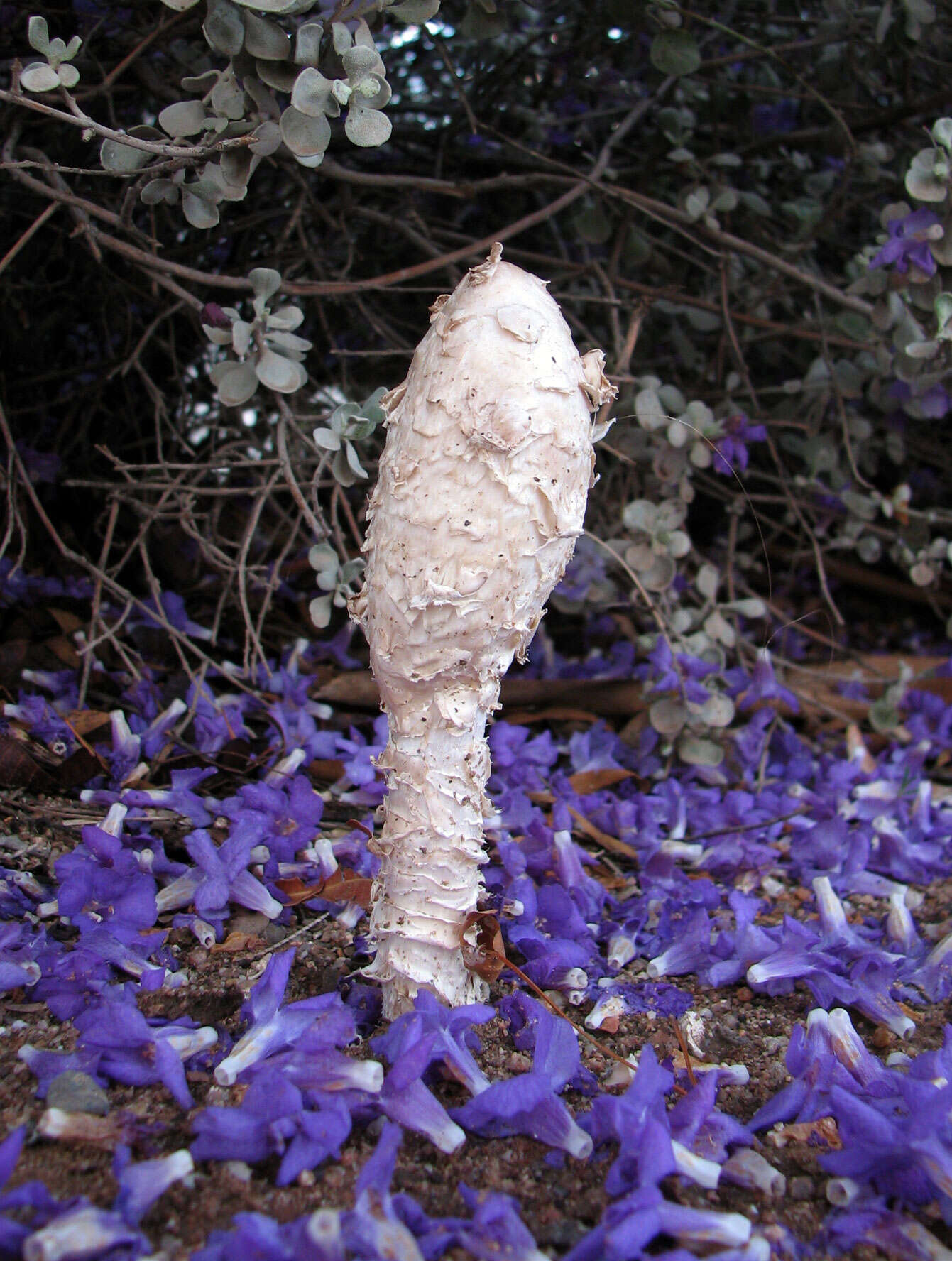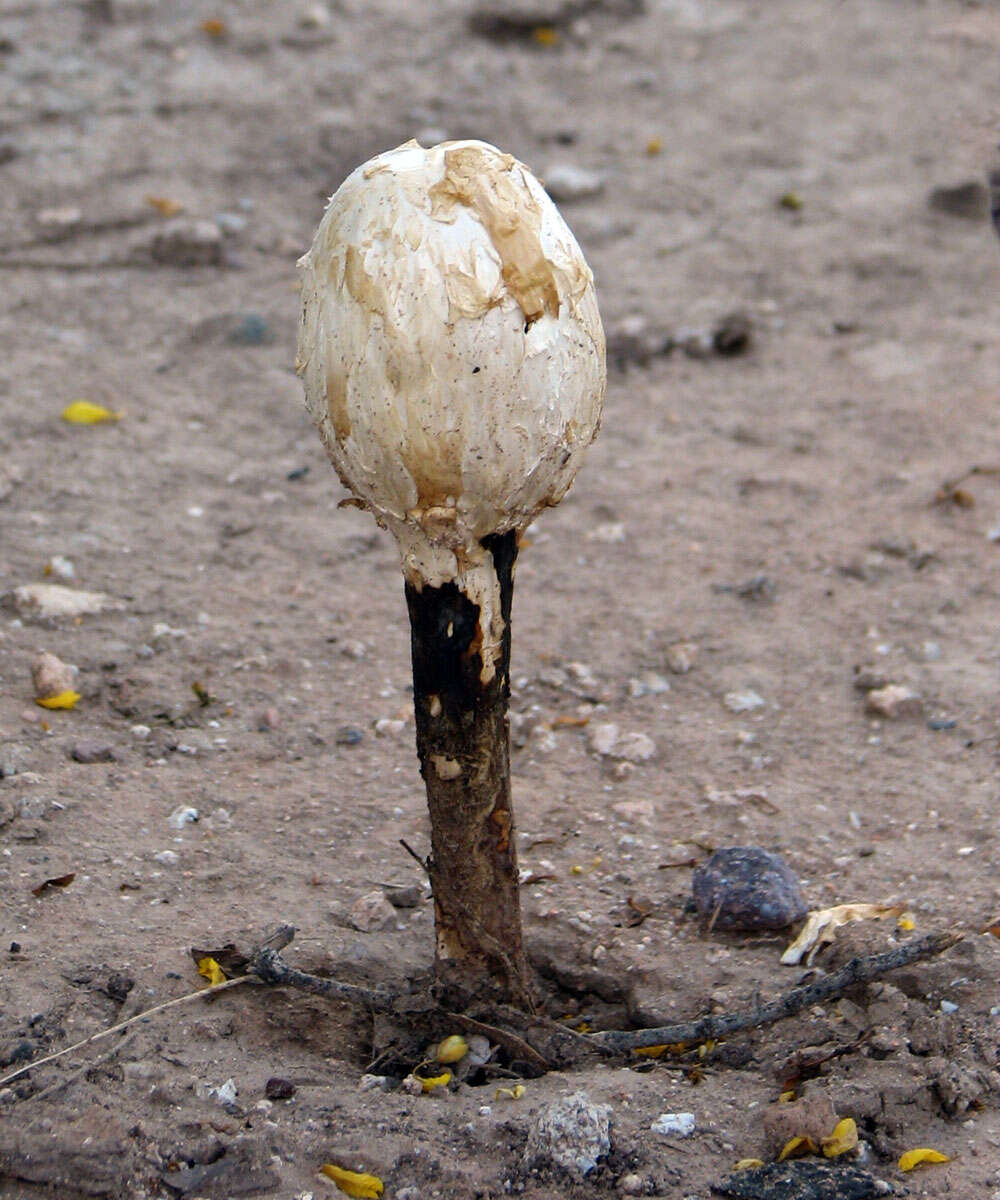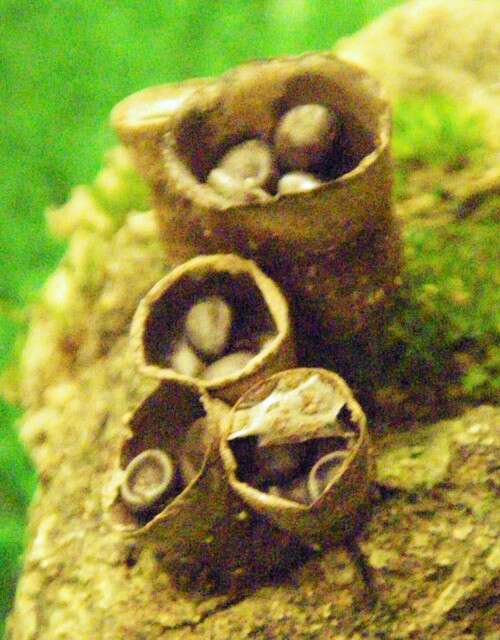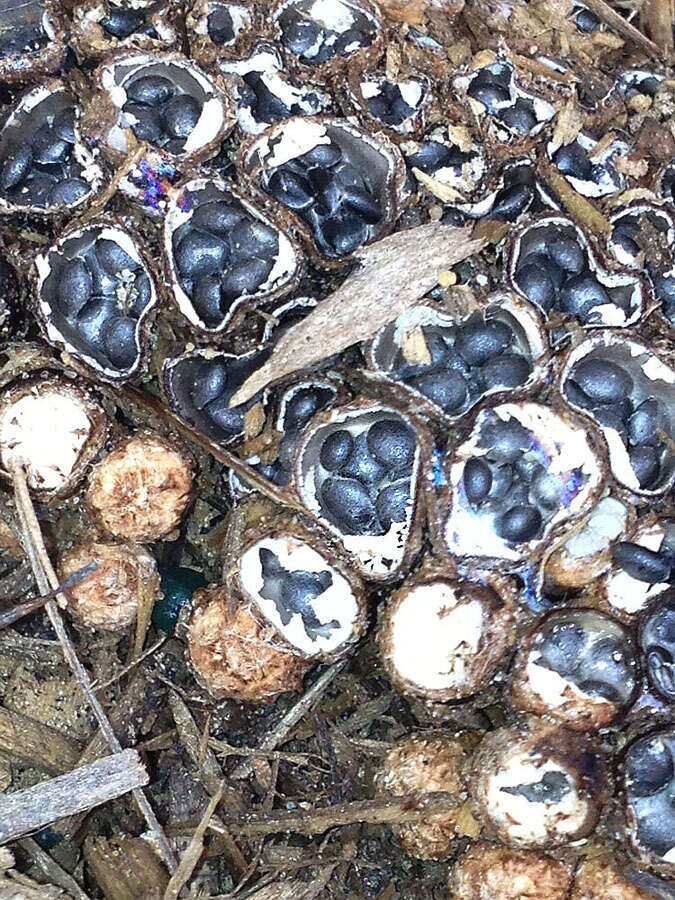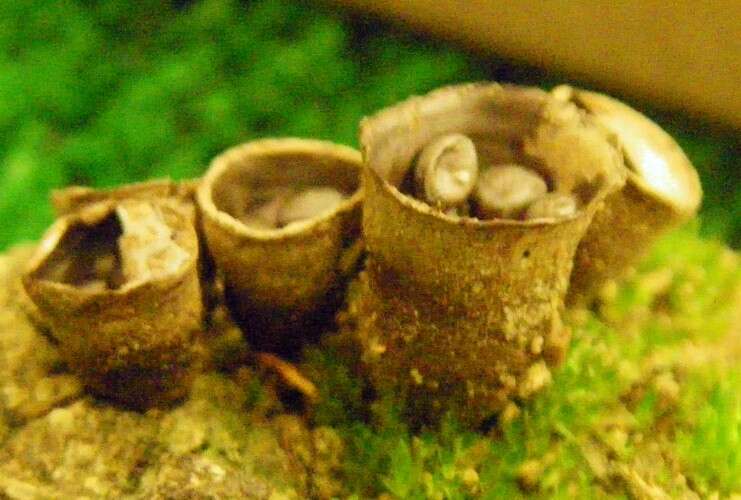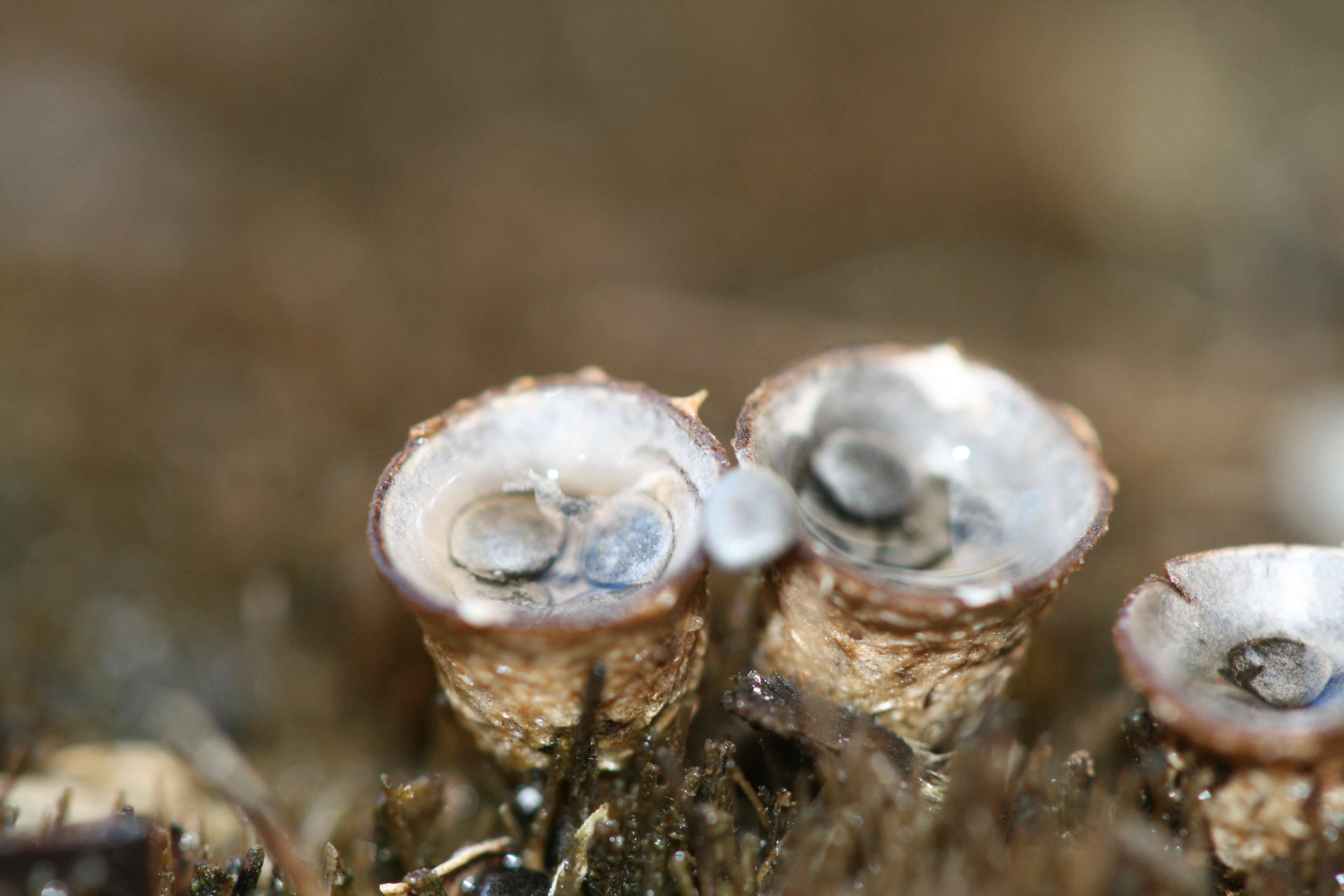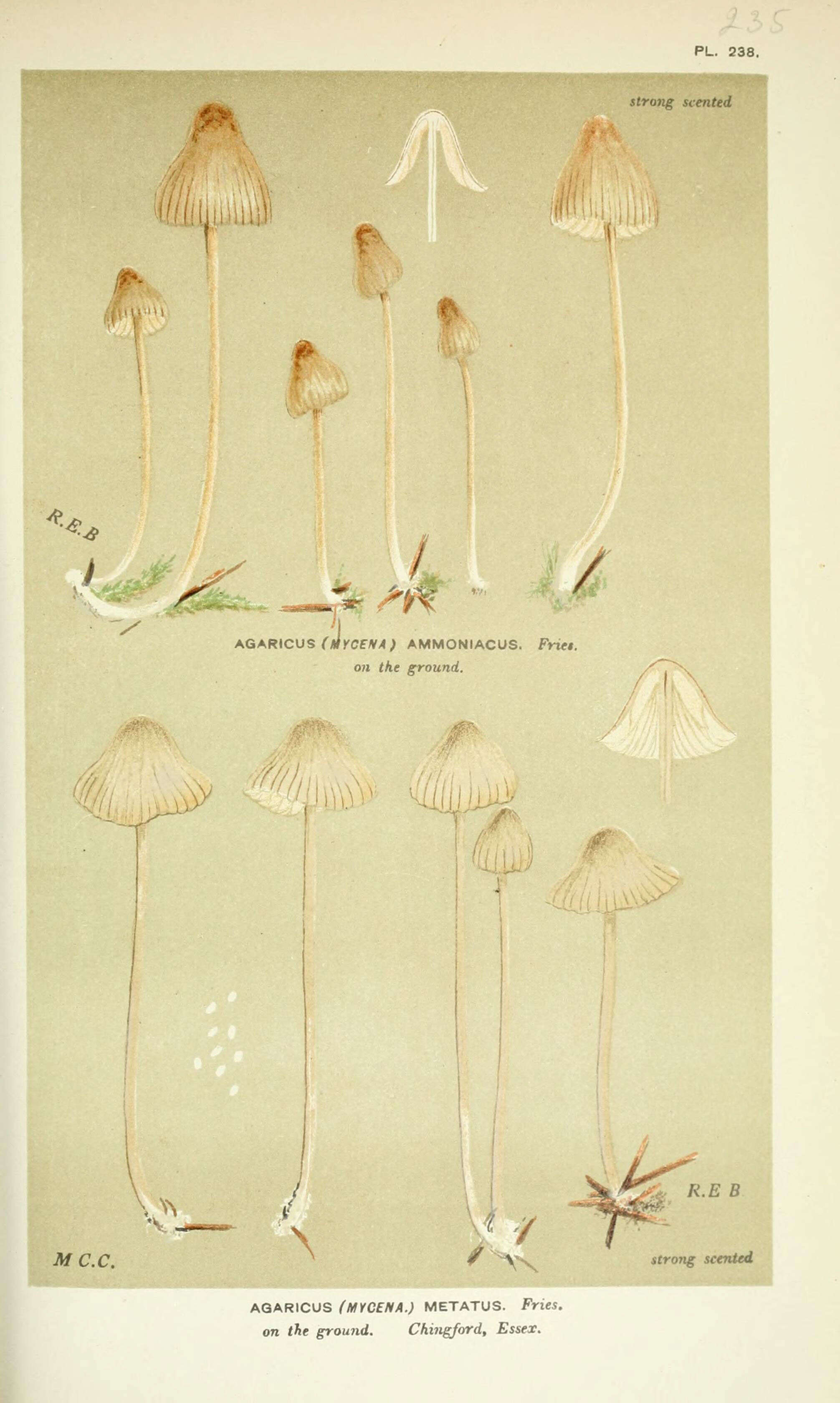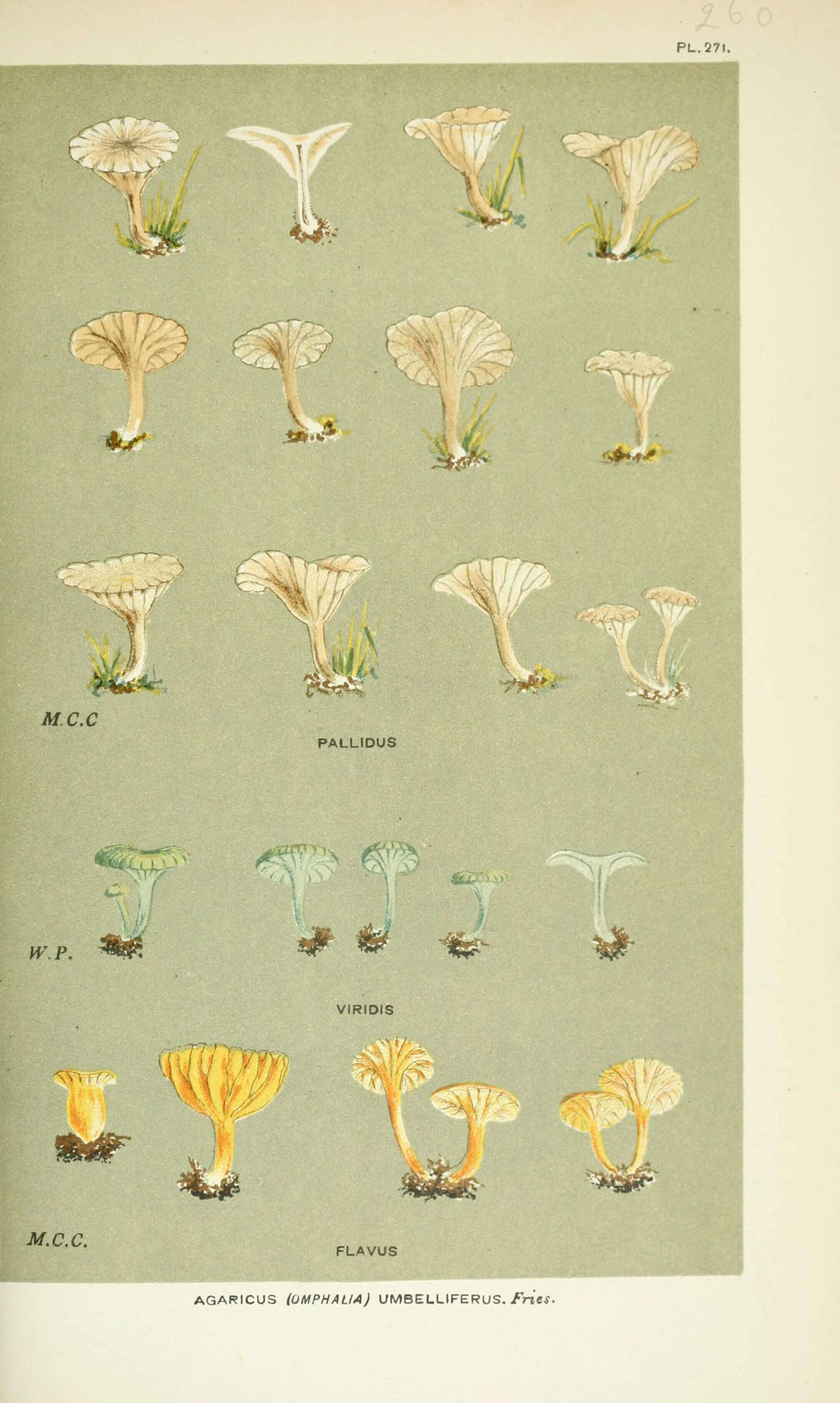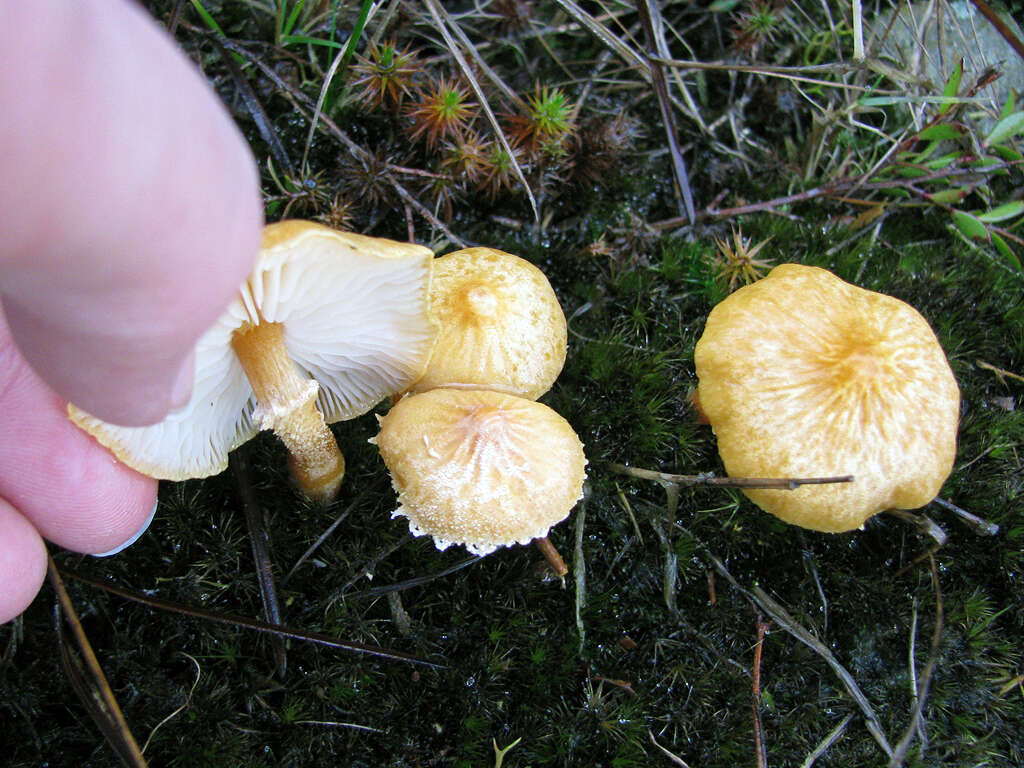-
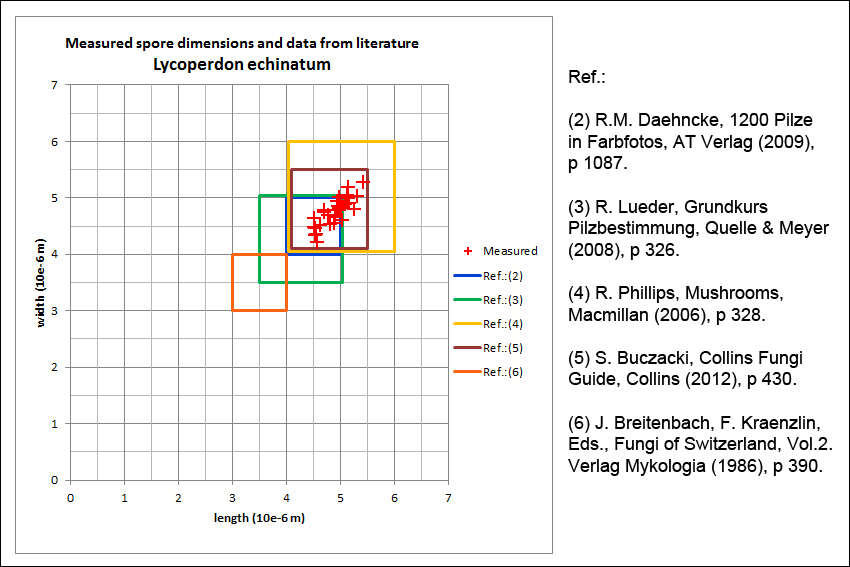
Lycoperdon echinatum Pers., syn.: Lycoperdon gemmatum var. echinatum (Pers.) Fr., Lycoperdon hoylei Berk. & Broome, Utraria echinata (Pers.) Qul.Spiny Puffball, DE: Igel-StublingSlo.: jeasta pranicaDat.: Sept. 20. 2014Lat.: 46.35183 Long.: 13.67390Code: Bot_839/2014_DSC4335Habitat: old mountain Fagus sylvatica forest with some Picea abies, south inclined mountain slope, calcareous ground, warm and relatively dry place, in shade, under a Fagus sylvatica tree, partly protected from direct rain by tree canopies, average precipitations ~ 3.000 mm/year, average temperature 5-7 deg C, elevation 1.025 m (3.350 feet), alpine phytogeographical region.Substratum: forest ground, organic debris on soil, mostly Fagus sylvatica leaves. Place: Lower Trenta valley, Lemovlje flats, near mountain trail to Mt. Bavki Grintavec, above the settlement Lemovlje, East Julian Alps, Posoje, Slovenia EC Comments: It is generally easy to recognize members of the genus Lycoperdon, although some species of genus Handkea, Vascellum or Scleroderma may cause confusion. The shape of their fruit bodies is more or less pear like and kids know very well they expel 'smoke' if they touch mature fruit bodies. However, to determine them on species level is more difficult. For example: If substrate is buried in the ground Lycoperdon pyriforme (which grows on wood) can easily be confused by Lycoperdon perlatum (which grows on ground); an old already brownish Lycoperdon perlatum can appear quite similar to Lycoperdon molle, etc. Neither shape nor color or surface of sporocarps or other individual morphological traits are reliable. All these vary significantly during life span of sporocarps and growing conditions. Only after gathering experience based on several finds in different conditions it gradually becomes easier to recognize them. Lycoperdon echinatum is an exception in this regard. Its sometimes up to 5 mm long spines covering the surface of the fruit bodies and distinctly brown color almost from the beginning of their development make the determination easy. Growing solitary, fruit body diameter 4.8 cm (spines included), stem-like base height 1.8 cm, diameter about 1.5 cm; spines up to 3 mm long, partly solitary and partly two to four fused at the top; SP and mature gleba brown-gray with slight purple-lilac tint, oac638 (but darker).Spores coarsely warty. Dimensions: 4,4 [4,9 ; 5] 5,5 x 4,3 [4,7 ; 4,9] 5,3 , Q = 1 [1,0] 1,1; N = 37; C = 95%, Me = 4,9 x 4,8 ; Qe = 1. Olympus CH20, NEA 100x/1.25, magnification 1.000 x, oil. AmScope MA500 digital camera.Herbarium: Mycotheca and lichen herbarium (LJU-Li) of Slovenian Forestry Institute, Vena pot 2, Ljubljana, Index Herbariorum LJFRef.:(1) Leg.: Jernej Trnkoczy(2) R.M. Daehncke, 1200 Pilze in Farbfotos, AT Verlag (2009), p 1087. (3) R. Lueder, Grundkurs Pilzbestimmung, Quelle & Meyer (2008), p 326.(4) R. Phillips, Mushrooms, Macmillan (2006), p 328.(5) S. Buczacki, Collins Fungi Guide, Collins (2012), p 430. e(6) J. Breitenbach, F. Kraenzlin, Eds., Fungi of Switzerland, Vol.2. Verlag Mykologia (1986), p 390. (7) G.J. Krieglsteiner (Hrsg.), Die Grosspilze Baden-Wrttembergs, Band 2., Ulmer (2000), p 142.
-
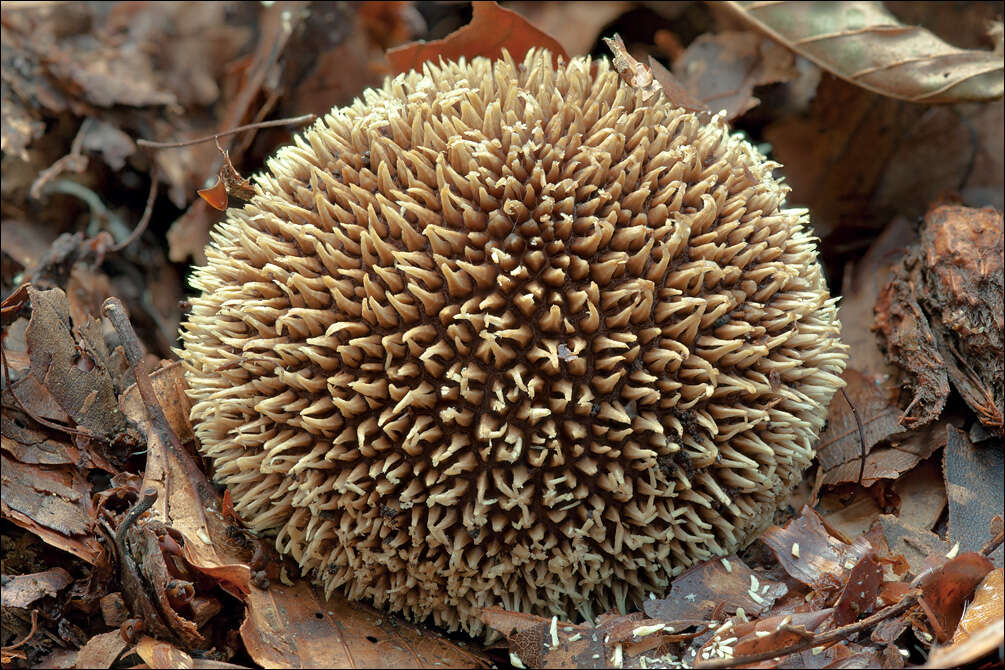
Lycoperdon echinatum Pers., syn.: Lycoperdon gemmatum var. echinatum (Pers.) Fr., Lycoperdon hoylei Berk. & Broome, Utraria echinata (Pers.) Qul.Spiny Puffball, DE: Igel-StublingSlo.: jeasta pranicaDat.: Sept. 20. 2014Lat.: 46.35183 Long.: 13.67390Code: Bot_839/2014_DSC4335Habitat: old mountain Fagus sylvatica forest with some Picea abies, south inclined mountain slope, calcareous ground, warm and relatively dry place, in shade, under a Fagus sylvatica tree, partly protected from direct rain by tree canopies, average precipitations ~ 3.000 mm/year, average temperature 5-7 deg C, elevation 1.025 m (3.350 feet), alpine phytogeographical region.Substratum: forest ground, organic debris on soil, mostly Fagus sylvatica leaves. Place: Lower Trenta valley, Lemovlje flats, near mountain trail to Mt. Bavki Grintavec, above the settlement Lemovlje, East Julian Alps, Posoje, Slovenia EC Comments: It is generally easy to recognize members of the genus Lycoperdon, although some species of genus Handkea, Vascellum or Scleroderma may cause confusion. The shape of their fruit bodies is more or less pear like and kids know very well they expel 'smoke' if they touch mature fruit bodies. However, to determine them on species level is more difficult. For example: If substrate is buried in the ground Lycoperdon pyriforme (which grows on wood) can easily be confused by Lycoperdon perlatum (which grows on ground); an old already brownish Lycoperdon perlatum can appear quite similar to Lycoperdon molle, etc. Neither shape nor color or surface of sporocarps or other individual morphological traits are reliable. All these vary significantly during life span of sporocarps and growing conditions. Only after gathering experience based on several finds in different conditions it gradually becomes easier to recognize them. Lycoperdon echinatum is an exception in this regard. Its sometimes up to 5 mm long spines covering the surface of the fruit bodies and distinctly brown color almost from the beginning of their development make the determination easy. Growing solitary, fruit body diameter 4.8 cm (spines included), stem-like base height 1.8 cm, diameter about 1.5 cm; spines up to 3 mm long, partly solitary and partly two to four fused at the top; SP and mature gleba brown-gray with slight purple-lilac tint, oac638 (but darker).Spores coarsely warty. Dimensions: 4,4 [4,9 ; 5] 5,5 x 4,3 [4,7 ; 4,9] 5,3 , Q = 1 [1,0] 1,1; N = 37; C = 95%, Me = 4,9 x 4,8 ; Qe = 1. Olympus CH20, NEA 100x/1.25, magnification 1.000 x, oil. AmScope MA500 digital camera.Herbarium: Mycotheca and lichen herbarium (LJU-Li) of Slovenian Forestry Institute, Vena pot 2, Ljubljana, Index Herbariorum LJFRef.:(1) Leg.: Jernej Trnkoczy(2) R.M. Daehncke, 1200 Pilze in Farbfotos, AT Verlag (2009), p 1087. (3) R. Lueder, Grundkurs Pilzbestimmung, Quelle & Meyer (2008), p 326.(4) R. Phillips, Mushrooms, Macmillan (2006), p 328.(5) S. Buczacki, Collins Fungi Guide, Collins (2012), p 430. e(6) J. Breitenbach, F. Kraenzlin, Eds., Fungi of Switzerland, Vol.2. Verlag Mykologia (1986), p 390. (7) G.J. Krieglsteiner (Hrsg.), Die Grosspilze Baden-Wrttembergs, Band 2., Ulmer (2000), p 142.
-
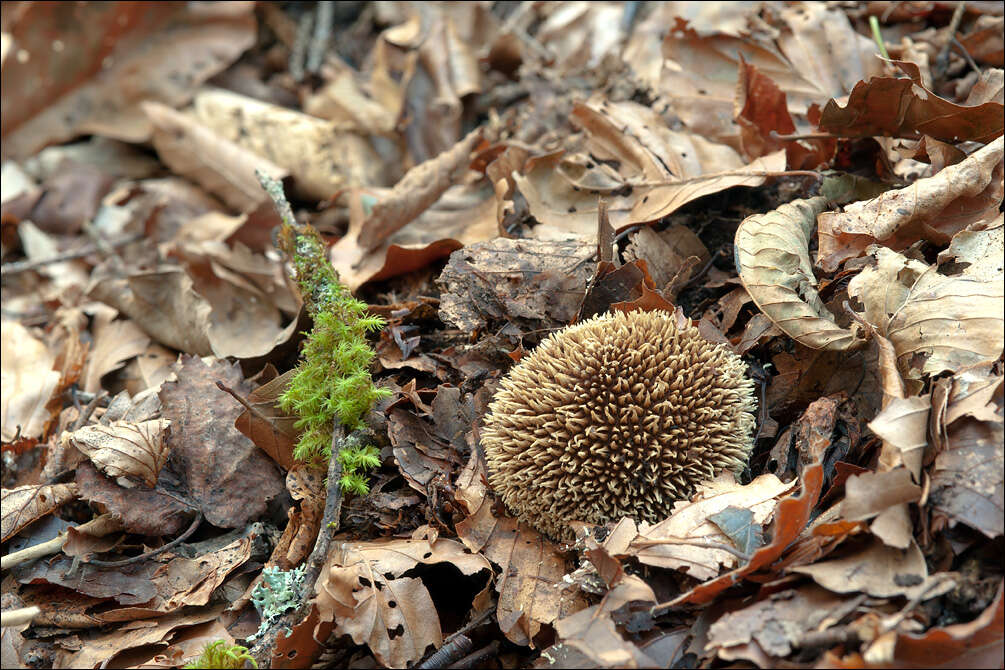
Lycoperdon echinatum Pers., syn.: Lycoperdon gemmatum var. echinatum (Pers.) Fr., Lycoperdon hoylei Berk. & Broome, Utraria echinata (Pers.) Qul.Spiny Puffball, DE: Igel-StublingSlo.: jeasta pranicaDat.: Sept. 20. 2014Lat.: 46.35183 Long.: 13.67390Code: Bot_839/2014_DSC4335Habitat: old mountain Fagus sylvatica forest with some Picea abies, south inclined mountain slope, calcareous ground, warm and relatively dry place, in shade, under a Fagus sylvatica tree, partly protected from direct rain by tree canopies, average precipitations ~ 3.000 mm/year, average temperature 5-7 deg C, elevation 1.025 m (3.350 feet), alpine phytogeographical region.Substratum: forest ground, organic debris on soil, mostly Fagus sylvatica leaves. Place: Lower Trenta valley, Lemovlje flats, near mountain trail to Mt. Bavki Grintavec, above the settlement Lemovlje, East Julian Alps, Posoje, Slovenia EC Comments: It is generally easy to recognize members of the genus Lycoperdon, although some species of genus Handkea, Vascellum or Scleroderma may cause confusion. The shape of their fruit bodies is more or less pear like and kids know very well they expel 'smoke' if they touch mature fruit bodies. However, to determine them on species level is more difficult. For example: If substrate is buried in the ground Lycoperdon pyriforme (which grows on wood) can easily be confused by Lycoperdon perlatum (which grows on ground); an old already brownish Lycoperdon perlatum can appear quite similar to Lycoperdon molle, etc. Neither shape nor color or surface of sporocarps or other individual morphological traits are reliable. All these vary significantly during life span of sporocarps and growing conditions. Only after gathering experience based on several finds in different conditions it gradually becomes easier to recognize them. Lycoperdon echinatum is an exception in this regard. Its sometimes up to 5 mm long spines covering the surface of the fruit bodies and distinctly brown color almost from the beginning of their development make the determination easy. Growing solitary, fruit body diameter 4.8 cm (spines included), stem-like base height 1.8 cm, diameter about 1.5 cm; spines up to 3 mm long, partly solitary and partly two to four fused at the top; SP and mature gleba brown-gray with slight purple-lilac tint, oac638 (but darker).Spores coarsely warty. Dimensions: 4,4 [4,9 ; 5] 5,5 x 4,3 [4,7 ; 4,9] 5,3 , Q = 1 [1,0] 1,1; N = 37; C = 95%, Me = 4,9 x 4,8 ; Qe = 1. Olympus CH20, NEA 100x/1.25, magnification 1.000 x, oil. AmScope MA500 digital camera.Herbarium: Mycotheca and lichen herbarium (LJU-Li) of Slovenian Forestry Institute, Vena pot 2, Ljubljana, Index Herbariorum LJFRef.:(1) Leg.: Jernej Trnkoczy(2) R.M. Daehncke, 1200 Pilze in Farbfotos, AT Verlag (2009), p 1087. (3) R. Lueder, Grundkurs Pilzbestimmung, Quelle & Meyer (2008), p 326.(4) R. Phillips, Mushrooms, Macmillan (2006), p 328.(5) S. Buczacki, Collins Fungi Guide, Collins (2012), p 430. e(6) J. Breitenbach, F. Kraenzlin, Eds., Fungi of Switzerland, Vol.2. Verlag Mykologia (1986), p 390. (7) G.J. Krieglsteiner (Hrsg.), Die Grosspilze Baden-Wrttembergs, Band 2., Ulmer (2000), p 142.
-
-
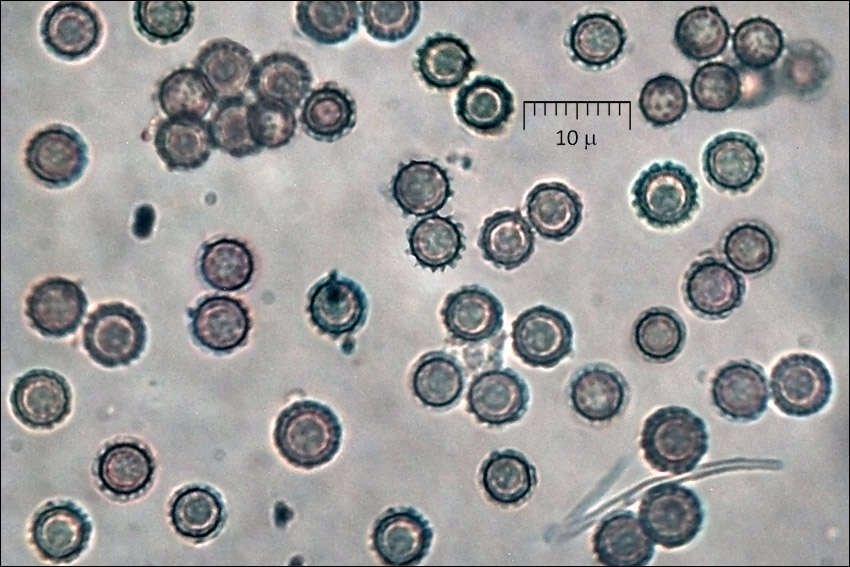
Lycoperdon echinatum Pers., syn.: Lycoperdon gemmatum var. echinatum (Pers.) Fr., Lycoperdon hoylei Berk. & Broome, Utraria echinata (Pers.) Qul.Spiny Puffball, DE: Igel-StublingSlo.: jeasta pranicaDat.: Sept. 20. 2014Lat.: 46.35183 Long.: 13.67390Code: Bot_839/2014_DSC4335Habitat: old mountain Fagus sylvatica forest with some Picea abies, south inclined mountain slope, calcareous ground, warm and relatively dry place, in shade, under a Fagus sylvatica tree, partly protected from direct rain by tree canopies, average precipitations ~ 3.000 mm/year, average temperature 5-7 deg C, elevation 1.025 m (3.350 feet), alpine phytogeographical region.Substratum: forest ground, organic debris on soil, mostly Fagus sylvatica leaves. Place: Lower Trenta valley, Lemovlje flats, near mountain trail to Mt. Bavki Grintavec, above the settlement Lemovlje, East Julian Alps, Posoje, Slovenia EC Comments: It is generally easy to recognize members of the genus Lycoperdon, although some species of genus Handkea, Vascellum or Scleroderma may cause confusion. The shape of their fruit bodies is more or less pear like and kids know very well they expel 'smoke' if they touch mature fruit bodies. However, to determine them on species level is more difficult. For example: If substrate is buried in the ground Lycoperdon pyriforme (which grows on wood) can easily be confused by Lycoperdon perlatum (which grows on ground); an old already brownish Lycoperdon perlatum can appear quite similar to Lycoperdon molle, etc. Neither shape nor color or surface of sporocarps or other individual morphological traits are reliable. All these vary significantly during life span of sporocarps and growing conditions. Only after gathering experience based on several finds in different conditions it gradually becomes easier to recognize them. Lycoperdon echinatum is an exception in this regard. Its sometimes up to 5 mm long spines covering the surface of the fruit bodies and distinctly brown color almost from the beginning of their development make the determination easy. Growing solitary, fruit body diameter 4.8 cm (spines included), stem-like base height 1.8 cm, diameter about 1.5 cm; spines up to 3 mm long, partly solitary and partly two to four fused at the top; SP and mature gleba brown-gray with slight purple-lilac tint, oac638 (but darker).Spores coarsely warty. Dimensions: 4,4 [4,9 ; 5] 5,5 x 4,3 [4,7 ; 4,9] 5,3 , Q = 1 [1,0] 1,1; N = 37; C = 95%, Me = 4,9 x 4,8 ; Qe = 1. Olympus CH20, NEA 100x/1.25, magnification 1.000 x, oil. AmScope MA500 digital camera.Herbarium: Mycotheca and lichen herbarium (LJU-Li) of Slovenian Forestry Institute, Vena pot 2, Ljubljana, Index Herbariorum LJFRef.:(1) Leg.: Jernej Trnkoczy(2) R.M. Daehncke, 1200 Pilze in Farbfotos, AT Verlag (2009), p 1087. (3) R. Lueder, Grundkurs Pilzbestimmung, Quelle & Meyer (2008), p 326.(4) R. Phillips, Mushrooms, Macmillan (2006), p 328.(5) S. Buczacki, Collins Fungi Guide, Collins (2012), p 430. e(6) J. Breitenbach, F. Kraenzlin, Eds., Fungi of Switzerland, Vol.2. Verlag Mykologia (1986), p 390. (7) G.J. Krieglsteiner (Hrsg.), Die Grosspilze Baden-Wrttembergs, Band 2., Ulmer (2000), p 142.
-

Lycoperdon echinatum Pers., syn.: Lycoperdon gemmatum var. echinatum (Pers.) Fr., Lycoperdon hoylei Berk. & Broome, Utraria echinata (Pers.) Qul.Spiny Puffball, DE: Igel-StublingSlo.: jeasta pranicaDat.: Sept. 20. 2014Lat.: 46.35183 Long.: 13.67390Code: Bot_839/2014_DSC4335Habitat: old mountain Fagus sylvatica forest with some Picea abies, south inclined mountain slope, calcareous ground, warm and relatively dry place, in shade, under a Fagus sylvatica tree, partly protected from direct rain by tree canopies, average precipitations ~ 3.000 mm/year, average temperature 5-7 deg C, elevation 1.025 m (3.350 feet), alpine phytogeographical region.Substratum: forest ground, organic debris on soil, mostly Fagus sylvatica leaves. Place: Lower Trenta valley, Lemovlje flats, near mountain trail to Mt. Bavki Grintavec, above the settlement Lemovlje, East Julian Alps, Posoje, Slovenia EC Comments: It is generally easy to recognize members of the genus Lycoperdon, although some species of genus Handkea, Vascellum or Scleroderma may cause confusion. The shape of their fruit bodies is more or less pear like and kids know very well they expel 'smoke' if they touch mature fruit bodies. However, to determine them on species level is more difficult. For example: If substrate is buried in the ground Lycoperdon pyriforme (which grows on wood) can easily be confused by Lycoperdon perlatum (which grows on ground); an old already brownish Lycoperdon perlatum can appear quite similar to Lycoperdon molle, etc. Neither shape nor color or surface of sporocarps or other individual morphological traits are reliable. All these vary significantly during life span of sporocarps and growing conditions. Only after gathering experience based on several finds in different conditions it gradually becomes easier to recognize them. Lycoperdon echinatum is an exception in this regard. Its sometimes up to 5 mm long spines covering the surface of the fruit bodies and distinctly brown color almost from the beginning of their development make the determination easy. Growing solitary, fruit body diameter 4.8 cm (spines included), stem-like base height 1.8 cm, diameter about 1.5 cm; spines up to 3 mm long, partly solitary and partly two to four fused at the top; SP and mature gleba brown-gray with slight purple-lilac tint, oac638 (but darker).Spores coarsely warty. Dimensions: 4,4 [4,9 ; 5] 5,5 x 4,3 [4,7 ; 4,9] 5,3 , Q = 1 [1,0] 1,1; N = 37; C = 95%, Me = 4,9 x 4,8 ; Qe = 1. Olympus CH20, NEA 100x/1.25, magnification 1.000 x, oil. AmScope MA500 digital camera.Herbarium: Mycotheca and lichen herbarium (LJU-Li) of Slovenian Forestry Institute, Vena pot 2, Ljubljana, Index Herbariorum LJFRef.:(1) Leg.: Jernej Trnkoczy(2) R.M. Daehncke, 1200 Pilze in Farbfotos, AT Verlag (2009), p 1087. (3) R. Lueder, Grundkurs Pilzbestimmung, Quelle & Meyer (2008), p 326.(4) R. Phillips, Mushrooms, Macmillan (2006), p 328.(5) S. Buczacki, Collins Fungi Guide, Collins (2012), p 430. e(6) J. Breitenbach, F. Kraenzlin, Eds., Fungi of Switzerland, Vol.2. Verlag Mykologia (1986), p 390. (7) G.J. Krieglsteiner (Hrsg.), Die Grosspilze Baden-Wrttembergs, Band 2., Ulmer (2000), p 142.
-
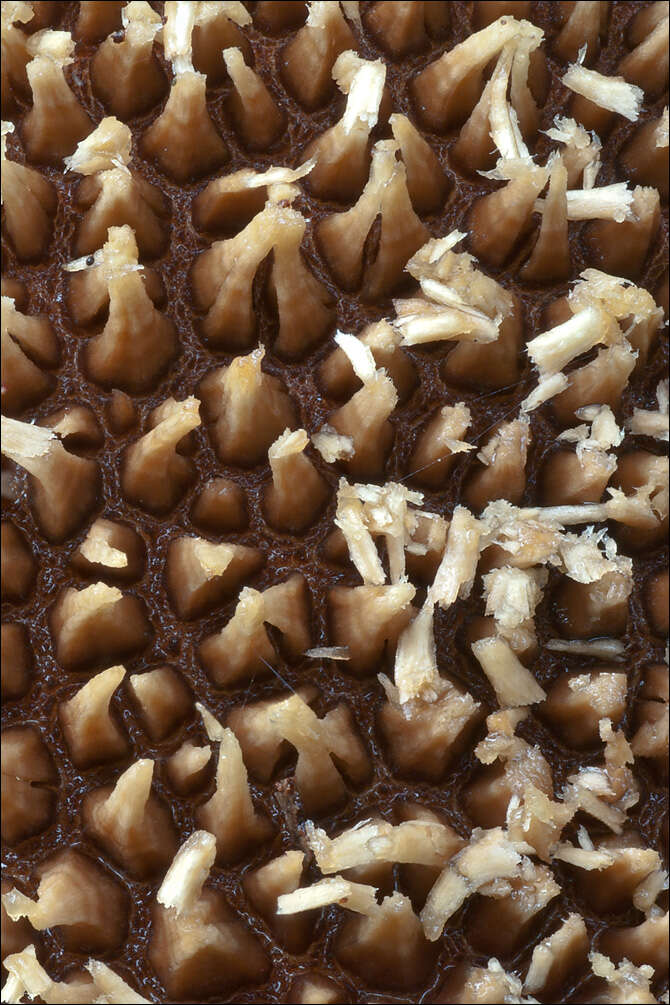
Lycoperdon echinatum Pers., syn.: Lycoperdon gemmatum var. echinatum (Pers.) Fr., Lycoperdon hoylei Berk. & Broome, Utraria echinata (Pers.) Qul.Spiny Puffball, DE: Igel-StublingSlo.: jeasta pranicaDat.: Sept. 20. 2014Lat.: 46.35183 Long.: 13.67390Code: Bot_839/2014_DSC4335Habitat: old mountain Fagus sylvatica forest with some Picea abies, south inclined mountain slope, calcareous ground, warm and relatively dry place, in shade, under a Fagus sylvatica tree, partly protected from direct rain by tree canopies, average precipitations ~ 3.000 mm/year, average temperature 5-7 deg C, elevation 1.025 m (3.350 feet), alpine phytogeographical region.Substratum: forest ground, organic debris on soil, mostly Fagus sylvatica leaves. Place: Lower Trenta valley, Lemovlje flats, near mountain trail to Mt. Bavki Grintavec, above the settlement Lemovlje, East Julian Alps, Posoje, Slovenia EC Comments: It is generally easy to recognize members of the genus Lycoperdon, although some species of genus Handkea, Vascellum or Scleroderma may cause confusion. The shape of their fruit bodies is more or less pear like and kids know very well they expel 'smoke' if they touch mature fruit bodies. However, to determine them on species level is more difficult. For example: If substrate is buried in the ground Lycoperdon pyriforme (which grows on wood) can easily be confused by Lycoperdon perlatum (which grows on ground); an old already brownish Lycoperdon perlatum can appear quite similar to Lycoperdon molle, etc. Neither shape nor color or surface of sporocarps or other individual morphological traits are reliable. All these vary significantly during life span of sporocarps and growing conditions. Only after gathering experience based on several finds in different conditions it gradually becomes easier to recognize them. Lycoperdon echinatum is an exception in this regard. Its sometimes up to 5 mm long spines covering the surface of the fruit bodies and distinctly brown color almost from the beginning of their development make the determination easy. Growing solitary, fruit body diameter 4.8 cm (spines included), stem-like base height 1.8 cm, diameter about 1.5 cm; spines up to 3 mm long, partly solitary and partly two to four fused at the top; SP and mature gleba brown-gray with slight purple-lilac tint, oac638 (but darker).Spores coarsely warty. Dimensions: 4,4 [4,9 ; 5] 5,5 x 4,3 [4,7 ; 4,9] 5,3 , Q = 1 [1,0] 1,1; N = 37; C = 95%, Me = 4,9 x 4,8 ; Qe = 1. Olympus CH20, NEA 100x/1.25, magnification 1.000 x, oil. AmScope MA500 digital camera.Herbarium: Mycotheca and lichen herbarium (LJU-Li) of Slovenian Forestry Institute, Vena pot 2, Ljubljana, Index Herbariorum LJFRef.:(1) Leg.: Jernej Trnkoczy(2) R.M. Daehncke, 1200 Pilze in Farbfotos, AT Verlag (2009), p 1087. (3) R. Lueder, Grundkurs Pilzbestimmung, Quelle & Meyer (2008), p 326.(4) R. Phillips, Mushrooms, Macmillan (2006), p 328.(5) S. Buczacki, Collins Fungi Guide, Collins (2012), p 430. e(6) J. Breitenbach, F. Kraenzlin, Eds., Fungi of Switzerland, Vol.2. Verlag Mykologia (1986), p 390. (7) G.J. Krieglsteiner (Hrsg.), Die Grosspilze Baden-Wrttembergs, Band 2., Ulmer (2000), p 142.
-
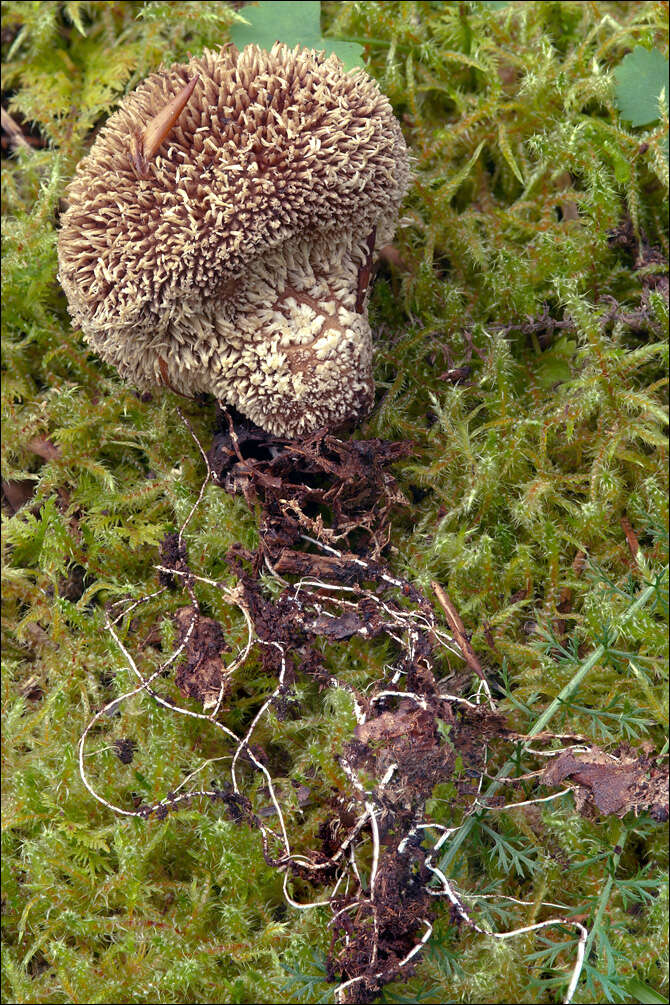
Lycoperdon echinatum Pers., syn.: Lycoperdon gemmatum var. echinatum (Pers.) Fr., Lycoperdon hoylei Berk. & Broome, Utraria echinata (Pers.) Qul.Spiny Puffball, DE: Igel-StublingSlo.: jeasta pranicaDat.: Sept. 20. 2014Lat.: 46.35183 Long.: 13.67390Code: Bot_839/2014_DSC4335Habitat: old mountain Fagus sylvatica forest with some Picea abies, south inclined mountain slope, calcareous ground, warm and relatively dry place, in shade, under a Fagus sylvatica tree, partly protected from direct rain by tree canopies, average precipitations ~ 3.000 mm/year, average temperature 5-7 deg C, elevation 1.025 m (3.350 feet), alpine phytogeographical region.Substratum: forest ground, organic debris on soil, mostly Fagus sylvatica leaves. Place: Lower Trenta valley, Lemovlje flats, near mountain trail to Mt. Bavki Grintavec, above the settlement Lemovlje, East Julian Alps, Posoje, Slovenia EC Comments: It is generally easy to recognize members of the genus Lycoperdon, although some species of genus Handkea, Vascellum or Scleroderma may cause confusion. The shape of their fruit bodies is more or less pear like and kids know very well they expel 'smoke' if they touch mature fruit bodies. However, to determine them on species level is more difficult. For example: If substrate is buried in the ground Lycoperdon pyriforme (which grows on wood) can easily be confused by Lycoperdon perlatum (which grows on ground); an old already brownish Lycoperdon perlatum can appear quite similar to Lycoperdon molle, etc. Neither shape nor color or surface of sporocarps or other individual morphological traits are reliable. All these vary significantly during life span of sporocarps and growing conditions. Only after gathering experience based on several finds in different conditions it gradually becomes easier to recognize them. Lycoperdon echinatum is an exception in this regard. Its sometimes up to 5 mm long spines covering the surface of the fruit bodies and distinctly brown color almost from the beginning of their development make the determination easy. Growing solitary, fruit body diameter 4.8 cm (spines included), stem-like base height 1.8 cm, diameter about 1.5 cm; spines up to 3 mm long, partly solitary and partly two to four fused at the top; SP and mature gleba brown-gray with slight purple-lilac tint, oac638 (but darker).Spores coarsely warty. Dimensions: 4,4 [4,9 ; 5] 5,5 x 4,3 [4,7 ; 4,9] 5,3 , Q = 1 [1,0] 1,1; N = 37; C = 95%, Me = 4,9 x 4,8 ; Qe = 1. Olympus CH20, NEA 100x/1.25, magnification 1.000 x, oil. AmScope MA500 digital camera.Herbarium: Mycotheca and lichen herbarium (LJU-Li) of Slovenian Forestry Institute, Vena pot 2, Ljubljana, Index Herbariorum LJFRef.:(1) Leg.: Jernej Trnkoczy(2) R.M. Daehncke, 1200 Pilze in Farbfotos, AT Verlag (2009), p 1087. (3) R. Lueder, Grundkurs Pilzbestimmung, Quelle & Meyer (2008), p 326.(4) R. Phillips, Mushrooms, Macmillan (2006), p 328.(5) S. Buczacki, Collins Fungi Guide, Collins (2012), p 430. e(6) J. Breitenbach, F. Kraenzlin, Eds., Fungi of Switzerland, Vol.2. Verlag Mykologia (1986), p 390. (7) G.J. Krieglsteiner (Hrsg.), Die Grosspilze Baden-Wrttembergs, Band 2., Ulmer (2000), p 142.
-
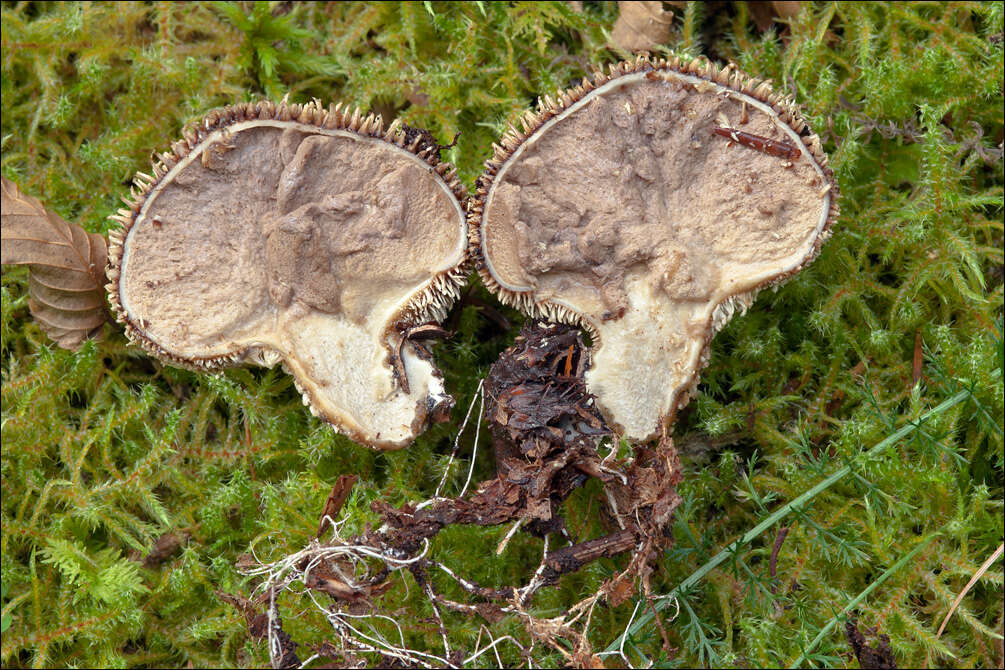
Lycoperdon echinatum Pers., syn.: Lycoperdon gemmatum var. echinatum (Pers.) Fr., Lycoperdon hoylei Berk. & Broome, Utraria echinata (Pers.) Qul.Spiny Puffball, DE: Igel-StublingSlo.: jeasta pranicaDat.: Sept. 20. 2014Lat.: 46.35183 Long.: 13.67390Code: Bot_839/2014_DSC4335Habitat: old mountain Fagus sylvatica forest with some Picea abies, south inclined mountain slope, calcareous ground, warm and relatively dry place, in shade, under a Fagus sylvatica tree, partly protected from direct rain by tree canopies, average precipitations ~ 3.000 mm/year, average temperature 5-7 deg C, elevation 1.025 m (3.350 feet), alpine phytogeographical region.Substratum: forest ground, organic debris on soil, mostly Fagus sylvatica leaves. Place: Lower Trenta valley, Lemovlje flats, near mountain trail to Mt. Bavki Grintavec, above the settlement Lemovlje, East Julian Alps, Posoje, Slovenia EC Comments: It is generally easy to recognize members of the genus Lycoperdon, although some species of genus Handkea, Vascellum or Scleroderma may cause confusion. The shape of their fruit bodies is more or less pear like and kids know very well they expel 'smoke' if they touch mature fruit bodies. However, to determine them on species level is more difficult. For example: If substrate is buried in the ground Lycoperdon pyriforme (which grows on wood) can easily be confused by Lycoperdon perlatum (which grows on ground); an old already brownish Lycoperdon perlatum can appear quite similar to Lycoperdon molle, etc. Neither shape nor color or surface of sporocarps or other individual morphological traits are reliable. All these vary significantly during life span of sporocarps and growing conditions. Only after gathering experience based on several finds in different conditions it gradually becomes easier to recognize them. Lycoperdon echinatum is an exception in this regard. Its sometimes up to 5 mm long spines covering the surface of the fruit bodies and distinctly brown color almost from the beginning of their development make the determination easy. Growing solitary, fruit body diameter 4.8 cm (spines included), stem-like base height 1.8 cm, diameter about 1.5 cm; spines up to 3 mm long, partly solitary and partly two to four fused at the top; SP and mature gleba brown-gray with slight purple-lilac tint, oac638 (but darker).Spores coarsely warty. Dimensions: 4,4 [4,9 ; 5] 5,5 x 4,3 [4,7 ; 4,9] 5,3 , Q = 1 [1,0] 1,1; N = 37; C = 95%, Me = 4,9 x 4,8 ; Qe = 1. Olympus CH20, NEA 100x/1.25, magnification 1.000 x, oil. AmScope MA500 digital camera.Herbarium: Mycotheca and lichen herbarium (LJU-Li) of Slovenian Forestry Institute, Vena pot 2, Ljubljana, Index Herbariorum LJFRef.:(1) Leg.: Jernej Trnkoczy(2) R.M. Daehncke, 1200 Pilze in Farbfotos, AT Verlag (2009), p 1087. (3) R. Lueder, Grundkurs Pilzbestimmung, Quelle & Meyer (2008), p 326.(4) R. Phillips, Mushrooms, Macmillan (2006), p 328.(5) S. Buczacki, Collins Fungi Guide, Collins (2012), p 430. e(6) J. Breitenbach, F. Kraenzlin, Eds., Fungi of Switzerland, Vol.2. Verlag Mykologia (1986), p 390. (7) G.J. Krieglsteiner (Hrsg.), Die Grosspilze Baden-Wrttembergs, Band 2., Ulmer (2000), p 142.
-
-
Queensland, Australia
-
Tucson, Arizona, United States
-
Tucson, Arizona, United States
-
-
Top Camp, Queensland, Australia
-
Photo by Ana Citrin, Goleta, California. A Birds Nest Fungus widespread on dung or on fertilized soil.
-
-
Top Camp, Queensland, Australia
-
Top Camp, Queensland, Australia
-
-
-
Photographed at the Frenchman's Cap lookout, on the Lyell Highway.
-
Cystoderma amianthinumEarthy Powdercap, Amiant-KoernchenschirmlingSlo.: rjava zrnovkaDate: Oct. 28. 2009Lat.: 46.36079 Long.: 13.70115Code: Bot_396/2009-0265Habitat: pasture, close to a wood side (Picea abies), fairly flat, shallow, calcareous, southeast faced ground, partly in shade, fully exposed to rain, average precipitations ~3.000 mm/year, average temperature 6-8 deg C, elevation 620 m (2.00 feet), alpine phytogeographical region. Substratum: mossy grassland, soilPlace: Trenta valley, upper part of Na Melu place, south-east slopes of Mt. Bavki Grintavec, 2.347 m (7.701 feet), East Julian Alps, Posoje, Slovenia ECComments: Spores 5.5 m (SD=0.4 m) x 3.4 m (SD=0.3 m), n=15, spore print creamy. Ref:Personal communication Mr. Bojan Rot,
www.gobenabovskem.si/M.Bon, Pareys Buch der Pilze, Kosmos (2005), p 172R.M.Daehncke, 1200 Pilze in Farbfotos, AT Verlag (2009), p 534R.Lueder, Grundkurs Pilzbestimmung, Quelle & Mayer (2008), p 220
www.mushroomexpert.com/cystoderma_amianthinum.html
-
Cystoderma amianthinumEarthy Powdercap, Amiant-KoernchenschirmlingSlo.: rjava zrnovkaDate: Oct. 28. 2009Lat.: 46.36079 Long.: 13.70115Code: Bot_396/2009-0265Habitat: pasture, close to a wood side (Picea abies), fairly flat, shallow, calcareous, southeast faced ground, partly in shade, fully exposed to rain, average precipitations ~3.000 mm/year, average temperature 6-8 deg C, elevation 620 m (2.00 feet), alpine phytogeographical region. Substratum: mossy grassland, soilPlace: Trenta valley, upper part of Na Melu place, south-east slopes of Mt. Bavki Grintavec, 2.347 m (7.701 feet), East Julian Alps, Posoje, Slovenia ECComments: Spores 5.5 m (SD=0.4 m) x 3.4 m (SD=0.3 m), n=15, spore print creamy. Ref:Personal communication Mr. Bojan Rot,
www.gobenabovskem.si/M.Bon, Pareys Buch der Pilze, Kosmos (2005), p 172R.M.Daehncke, 1200 Pilze in Farbfotos, AT Verlag (2009), p 534R.Lueder, Grundkurs Pilzbestimmung, Quelle & Mayer (2008), p 220
www.mushroomexpert.com/cystoderma_amianthinum.html


